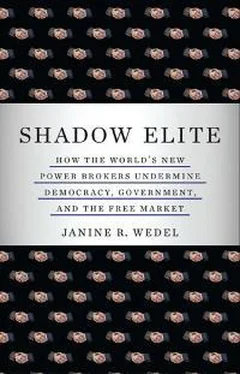Take, for instance, the United States, where the adaptability required in a consulting life goes hand in hand with declining job security. The U.S. Department of Labor reported that the youngest of the baby boomers (those born between 1957 and 1964) held “large numbers of short-duration jobs even as they approached middle age.” Younger workers were likely to change jobs even more frequently. The Department’s study, which captured employment duration realities in the 1990s and into 2007, found that, among jobs begun by workers when they were thirty-three to thirty-seven years old, nearly a half ended in less than one year, and more than four-fifths ended in less than five years. Changes in the labor market—fewer good jobs that are harder to obtain and provide less security if you do get one, making more necessary shifts in employment—underpin these trends, which are only intensified by the economic meltdown. When institutions are no longer loyal to their employees, the smart thing is not to be loyal to an institution that may not be loyal to you. 6
With consulting as a new way, among others, of being in the world, new qualities are prized: Self-managed, self-driving self-starters are in, while company men are out; elasticity is lauded, rigidity is not; “proactivity” is prized, passivity is passé; networks and “networking” are au courant, bureaucracy is scorned. New formations—self-starting organizations and groups, make-it-up-as-you-go-along structures and career paths—are encouraged, along with flexible identities. In short, improvisation and shifting affiliation are rewarded; loyalty to institutions is not. Although in some cases networks replace bureaucracy, mostly they just penetrate, subvert, or otherwise reorganize it. Today’s star influencers have little use for the clear-cut arrangements of the past. They merrily innovate as they go along. 7
These qualities and ways of being have flourished amid the four transformational developments: the redesign of governing; the end of the Cold War; the advent of evermore complex technologies; and the embrace of truthiness. (“Globalization,” or the increased flow of goods, services, and capital across nations, is intertwined with all four developments, although this is not a subject of elaboration here.) These developments, or restructuring forces, caused by both design and default, have converged in an interactive spiral to rearrange authority on a global scale and spawn new institutional forms of governing and of power and influence in which official and private are melded, or power is simply privatized. Each development has been accompanied by a narrative—sometimes quite grand, like “the end of history”—that shapes public understanding of the world. Some of the results of these developments have worked to make responsibility more difficult to pin down, and, in time, rendered the public more reliant on the accounts and ethics of the players themselves. Meanwhile, the narratives not only mask the results, but also make it more difficult to see their consequences for democracy.
Redesigning Governing
There are good reasons for the first transformational development, the re-design of governing . When (as in Rašidagić’s case) government barely exists, people and organizations improvise to get things done—in short, they (re)invent it. On the other hand, when unbending bureaucracies prove exasperating, there are calls in a democratic society for flexibility to make them more user friendly. David Osborne and Ted Gaebler, authors of the influential Reinventing Government: How the Entrepreneurial Spirit Is Transforming the Public Sector , published in 1992, criticized governments for their “sluggish, centralized bureaucracies, their preoccupations with rules and regulations, and their hierarchical chains of command.” These ideas resonated; Reinventing Government became a best seller, even though its dry case studies largely treat state and local governments. The authors gave new voice to a prevalent critique of government that had been expressed before in various incarnations and that would hasten the redesign of governing. 8
The vision of a streamlined state burst onto the public stage in the United States and the United Kingdom in the early 1980s, with Ronald Reagan and his ideological soul mate, Margaret Thatcher, leading the rhetorical charge. 9Streamlining the state is part of a grab bag of ideas and policies often referred to as “neoliberalism,” a term I employ sparingly because it can describe considerably different policies, not to mention differing local adaptations to them. While classical liberal philosophy (harking back to the Enlightenment) sought to safeguard individual rights from state power, protect private property, and enshrine laissez-faire economics, neoliberal policies of the past several decades emphasize modest-size government, minimal restrictions on business, and open markets. Thus Reagan campaigned against “big government” and presided over an age of deregulation, relaxing constraints on industry, while Thatcher pressed to privatize the economy by selling government-owned enterprises. 10The redesign of governing had its origins in these policy reforms (especially those dealing with government itself), as well as in expanded executive power, which often was necessary to implement neoliberal reform. With their roots in the Anglo-Saxon world, neoliberal ideas and policies would travel the globe in varying constellations. 11
Efforts to limit the size of government, replete with attempts to make government more like business and to enlist private actors in its work, implicitly challenged the model of bureaucracy elucidated by Max Weber in the early twentieth century—one with clear distinctions between the state and private sectors and regulated through professional administration, that is, formal, impersonal structures rather than personalistic ones. Neoliberal policies, first implemented in Anglo-Saxon contexts that comported more to Weber’s model (with all models, of course, encountering challenges when they butt up against reality), were hardly friendly to it. In fact, Americans’ observation of East Asia, especially Japan, in which the division between state and private never existed in the Weberian sense, may even have contributed to the appeal of neoliberal ideas at a time when America was perceived to be on the decline and falling behind in the competition with Japan. Whatever the impetus, neoliberalism helped occasion a breakdown of the distinction between state and private, bureaucracy and market. 12
A brief sketch of the trajectory of neoliberal reform sheds light on this breakdown—as the wellspring of today’s redesign of governing—and its results. The “Reagan revolution” sanctified the practice of contracting out government services, ostensibly to control costs while letting governing entities concentrate on their central mission. (The United States was already a pioneer in contracting, with the Manhattan Project of World War II and Project RAND, established in 1946, among the templates.) As well, enlisting nongovernmental actors and forging collaborative relations with private entities (as in public-private partnerships) would make government more responsive and efficient. Again, the United States, with its history of private bodies building railroads, universities, and civic institutions, took the lead. 13
Business was the model for government. In 1976, Ronald Reagan, while running for president, foresaw the ideal state as one in which “modern business practices could make government more efficient, economical, and responsive.” The “new public management,” which gained currency in the 1980s, sought to apply business principles such as competition and an emphasis on outcomes to government. Heading up President Bill Clinton’s “reinventing government” initiative in the 1990s, Vice President Al Gore echoed the point: “We need to adopt the very best management techniques from the private sector to create governments that are fully prepared for the Information Age.” An example is his promised civil service reform, “based on an insight that is common in private industry: you pay for performance.” (Of course, that maxim has not been applied equally. Many CEOs are not paid for performance but paid whatever their “performance.”) The injection of business principles into government was reflected in the language: Recipients of state services become “customers” and citizens “shareholders,” while hierarchy gives way to “participation” and “teamwork,” and rule-driven to “mission-driven” government. 14
Читать дальше












